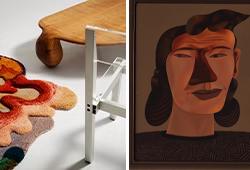Helene Schjerfbeck
"Madonna de la Charité"
Signed H.S., d'après Greco. Relined canvas 61 x 49.5 cm. Conceived 1941.
Täydennyslista
Relined canvas.
Alkuperä - Provenienssi
The collection of Gunhild Åhlén, Stockholm, Sweden.
Private collection, Sweden.
Näyttelyt
Stenmans konstsalong, "Helene Schjerfbeck Hyllningsutställning", Stockholm, Sweden 1942, catalogue no 85.
Stenmans Konstsalong, "Helene Schjerfbeck", Stockholm, Sweden 1944, catalogue no118.
Stenmans Konstsalong, "Helene Schjerfbeck In Memoriam", Stockholm, Sweden 1946, catalogue no 115.
Stenmans Konstsalong, "Helene Schjerfbeck", Stockholm, Sweden 1954, catalogue no 94.
Stenmans Konstsalong, "Helene Schjerfbeck", Stockholm, Sweden 1958, catalogue no 92.
Ateneum, Helsingfors, Finland, "Helene Schjerfbeck", 1th June - 14th October 2012, catalogue no 644.
Kirjallisuus
H. Ahtela, "Helena Schjerfbeck", 1953, illustrated full page 257 and listet, no 874, p.370.
"Helene Schjerfbeck", exhibitioncatalogue, Ateneum, Helsingfors, Finland, 1992, catalogue no 444, illustrated p. 270.
Leena Ahtola-Moorehouse (ed.), "Helene Schjerfbeck", exhibitioncatalogue, Ateneum, Helsingfors, Finland, 2012, catalogue no: 644, illustrated p. 318.
Muut tiedot
The deeply moving Madonna de la Charité is one of the artist Helene Schjerfbeck’s most outstanding works from the later period. When the painting was created in the middle of the war, in 1941, she was 79 years old and returned to the influence of El Greco for inspiration. The work belongs to one of Schjerfbeck’s more important interpretations of the old master's creations. The downward-gazing beautiful Madonna is beyond worldly things and exudes both tranquility and harmony. It is typical of many of Schjerfbeck’s portrayals of enigmatic fragility.
"A strong, simple, delicate art, great in feeling that I wanted to create" Schjerfbeck wrote in a letter to her friend Einar Reuter.
In her art studies Schjerfbeck came in contact with the Italian medieval paintings and early renaissance art. While studying in Paris, she was able to visit the collections at the Louvre and study the old masters works but she also took an active part in the gallery’s exhibitions of contemporary art. During her life she had been inspired by both the contemporary art scene aswell as the the old masters' paintings and she studied both Edelfelt’s, Cezanne’s, Picasso's work as well as Botticelli’s, Holbein’s or Fra Angelico’s. The whole time, she developed her own expression, refining their techniques. "I paint because I have seen paintings that made me happy, and an inner force is pushing me to strive to do something like that”…..”It has never yet succeeded. Therefor I paint…" Schjerfbeck wrote.
During the study which Schjerfbeck undertook she travelled to Florence and Rome but also Vienna and St. Petersburg, she studied all the old masters and copied there styles.
In 1902 she moved with her sickly mother to the small town of Hyvinge north of Helsinki in Finland, where they came to live for twenty years and it was during these years she developed her painting in a more modernistic direction. During this period her art was refined and typified with a more stripped-down and simplified personal idiom.
She missed travelling but she continued to follow the developing of the arts in magazines such as L'Art et les Artiste or newly published art books. The realism of her earlier paintings in the 1880s - and '90s was now exchanged for a reduction of lines and details.
From around 1910 and onwards she was increesingly aware of the Spanish Renaissance master El Greco's art from the late 1500’s and it would lead to a long and deep admiration and even influence. Schjerfbeck never came to visit Spain and only saw one of his paintings in real life but in countless letters, she describes how El Greco's art appealed to her.
In 1919 Schjerfbeck wrote in a letter: "Yesterday evening I lay and looked at Greco”…”and I got the urge to emulate this small painting ...".
El Greco's faces with there characteristic deep shadows as well as the manieristic extended lines mesmerized her.
In 1928 she created her first painting especially in the style of the master's work and this is the painting called Angel Fragments. However in Schjerfbeck’s interpretation of the composition, she has chosen brighter colors and her angelic faces portrays in milder tones.
Helene Schjerfbeck’s friend and art dealer Gösta Stenman supplied her with books and images of and by El Greco. These where often black and white images from photographs, reproduction, and during the 40’s she created a series of reinterpretations. During the turbulent years of the war, she had difficulty finding models for her paintings so she gladly took inspiration from art books. Often she took out details of his work but supplementing these with her own style. By this point she was influenced by the emerging school of modernism. With a cooler palette than El Greco's, she made these pictures her own. During this time she also created several of her famous self-portraits.
Leena Ahtola-Moorhouse, curator of the museum Atheneum in Finland, so incisively describes it in the 2012's extensive exhibition catalogue about Schjerfbeck: "Schjerfbeck is among the most recognizable Finnish artists. She is a splendid example of one who seekes to move the world and provoke a discussion in order to impose her own vision and her own depth. Otherwise, the world will be unmoved."
Women and girls recur as a motif in many of Schjerfbeck’s work. These depictions were more than simple images and can rather be characterized as studies of the human soul. The emphasis shifted to mood and light rather than of details of clothes and faces.
Schjerfbeck is an artist who is considered among the greatest of her contemporarys. In the painting Madonna de la Charité, we can see when the artist with her quiet personal and tranquil painting reaches her zenith. Svenska Dagbladets art critic Gotthard Johansson wrote: "Confronted with Helene Schjerfbeck’s art the question of old or new, yes, even good or bad is silenced. Here you stand before great art, this is a sacred space. "

































